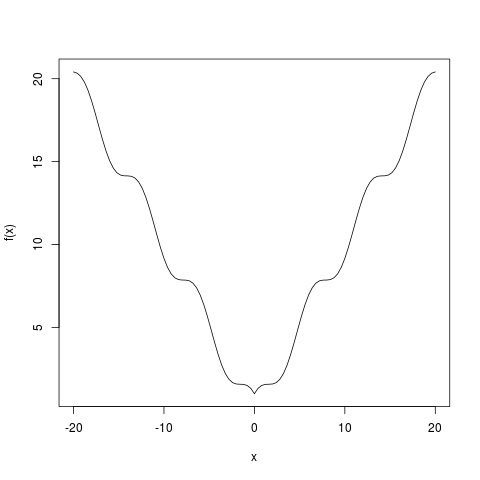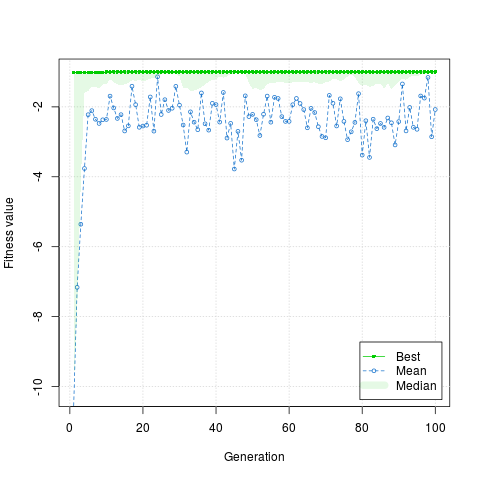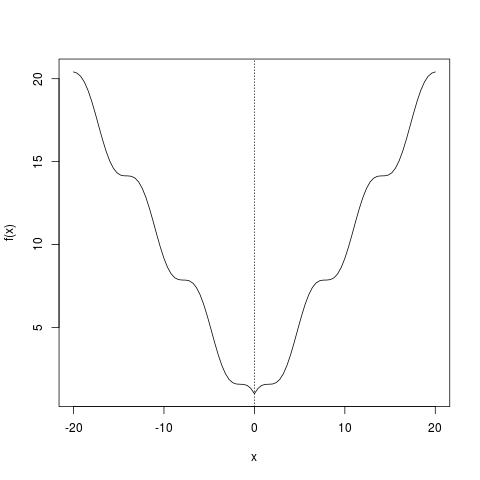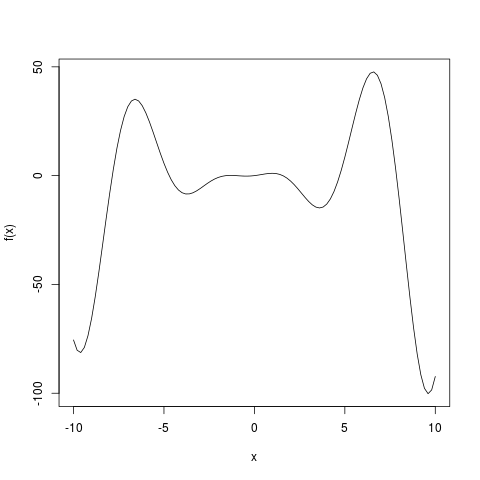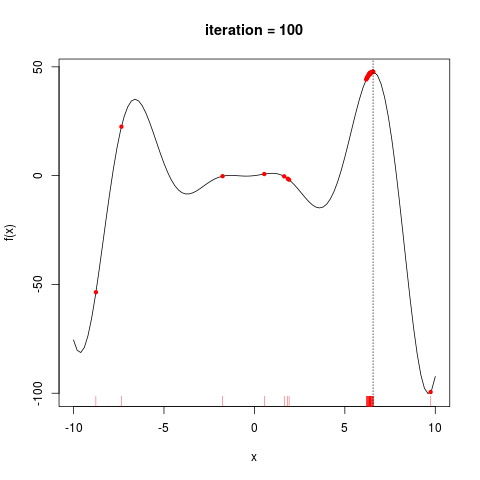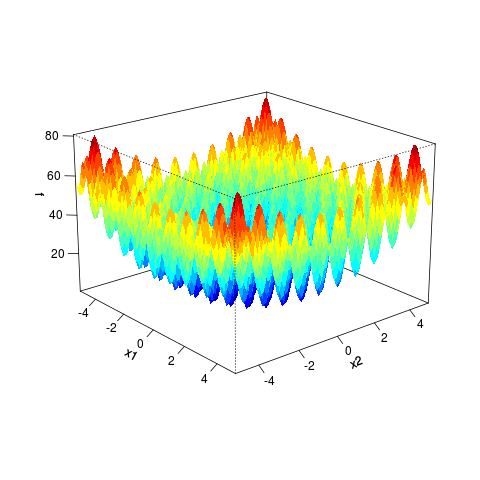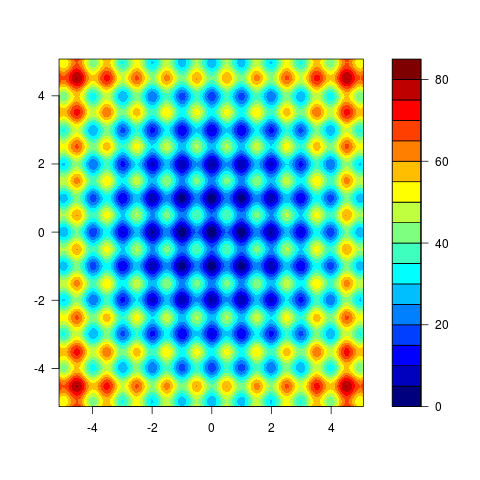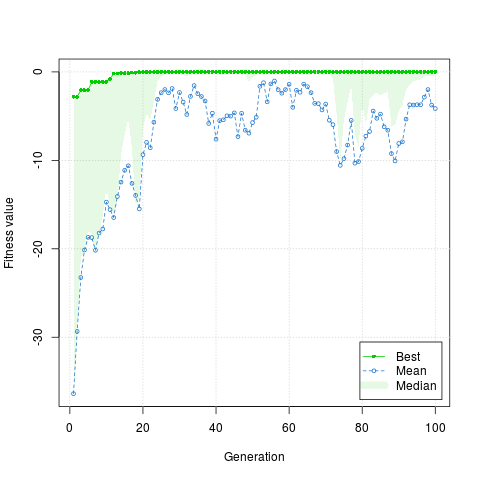Supported by Dr. Osamu Ogasawara and  providing providing  . . |
|
Last data update: 2014.03.03 |
Genetic AlgorithmsDescriptionMaximization of a fitness function using genetic algorithms (GAs). Local search using general-purpose optimisation algorithms can be applied stochastically to exploit interesting regions. The algorithm can be run sequentially or in parallel using an explicit master-slave parallelisation. Usage
ga(type = c("binary", "real-valued", "permutation"),
fitness, ...,
min, max, nBits,
population = gaControl(type)$population,
selection = gaControl(type)$selection,
crossover = gaControl(type)$crossover,
mutation = gaControl(type)$mutation,
popSize = 50,
pcrossover = 0.8,
pmutation = 0.1,
elitism = base::max(1, round(popSize*0.05)),
updatePop = FALSE,
postFitness = NULL,
maxiter = 100,
run = maxiter,
maxFitness = Inf,
names = NULL,
suggestions = NULL,
optim = FALSE,
optimArgs = list(method = "L-BFGS-B",
poptim = 0.05,
pressel = 0.5,
control = list(fnscale = -1, maxit = 100)),
keepBest = FALSE,
parallel = FALSE,
monitor = if(interactive())
{ if(is.RStudio()) gaMonitor else gaMonitor2 }
else FALSE,
seed = NULL)
Arguments
DetailsGenetic algorithms (GAs) are stochastic search algorithms inspired by the basic principles of biological evolution and natural selection. GAs simulate the evolution of living organisms, where the fittest individuals dominate over the weaker ones, by mimicking the biological mechanisms of evolution, such as selection, crossover and mutation. The GA package is a collection of general purpose functions that provide a flexible set of tools for applying a wide range of genetic algorithm methods. The Default genetic operators are set via gaControl("binary")
gaControl("real-valued")
gaControl("permutation")
ValueReturns an object of class Author(s)Luca Scrucca luca.scrucca@unipg.it ReferencesBack T., Fogel D., Michalewicz Z. (2000). Evolutionary Computation 1: Basic Algorithms and Operators. IOP Publishing Ltd., Bristol and Philadelphia. Back T., Fogel D., Michalewicz Z. (2000b). Evolutionary Computation 2: Advanced Algorithms and Operators. IOP Publishing Ltd., Bristol and Philadelphia. Coley D. (1999). An Introduction to Genetic Algorithms for Scientists and Engineers. World Scientific Pub. Co. Inc., Singapore. Eiben A., Smith J. (2003). Introduction to Evolutionary Computing. Springer-Verlag, Berlin Heidelberg. Goldberg D. (1989). Genetic Algorithms in Search, Optimization, and Machine Learning. Addison-Wesley Professional, Boston, MA. Haupt R. L., Haupt S. E. (2004). Practical Genetic Algorithms. 2nd edition. John Wiley & Sons, New York. Luke S. (2013) Essentials of Metaheuristics, 2nd edition. Lulu. Freely available at http://cs.gmu.edu/~sean/book/metaheuristics/. Scrucca L. (2013). GA: A Package for Genetic Algorithms in R. Journal of Statistical Software, 53(4), 1-37, http://www.jstatsoft.org/v53/i04/. Scrucca L. (2016). On some extensions to GA package: hybrid optimisation, parallelisation and islands evolution. Submitted to R Journal. Pre-print available at http://arxiv.org/abs/1605.01931. Simon D. (2013) Evolutionary Optimization Algorithms. John Wiley & Sons. Sivanandam S., Deepa S. (2007). Introduction to Genetic Algorithms. Springer-Verlag, Berlin Heidelberg. Yu X., Gen M. (2010). Introduction to Evolutionary Algorithms. Springer-Verlag, Berlin Heidelberg. See Also
Examples
# 1) one-dimensional function
f <- function(x) abs(x)+cos(x)
curve(f, -20, 20)
fitness <- function(x) -f(x)
GA <- ga(type = "real-valued", fitness = fitness, min = -20, max = 20)
summary(GA)
plot(GA)
curve(f, -20, 20)
abline(v = GA@solution, lty = 3)
# 2) one-dimensional function
f <- function(x) (x^2+x)*cos(x) # -10 < x < 10
curve(f, -10, 10)
# write your own tracing function
monitor <- function(obj)
{
curve(f, -10, 10, main = paste("iteration =", obj@iter))
points(obj@population, obj@fitness, pch = 20, col = 2)
rug(obj@population, col = 2)
Sys.sleep(0.2)
}
## Not run:
GA <- ga(type = "real-valued", fitness = f, min = -10, max = 10, monitor = monitor)
## End(Not run)
# or if you want to suppress the tracing
GA <- ga(type = "real-valued", fitness = f, min = -10, max = 10, monitor = NULL)
summary(GA)
monitor(GA)
abline(v = GA@solution, lty = 3)
# 3) two-dimensional Rastrigin function
Rastrigin <- function(x1, x2)
{
20 + x1^2 + x2^2 - 10*(cos(2*pi*x1) + cos(2*pi*x2))
}
x1 <- x2 <- seq(-5.12, 5.12, by = 0.1)
f <- outer(x1, x2, Rastrigin)
persp3D(x1, x2, f, theta = 50, phi = 20)
filled.contour(x1, x2, f, color.palette = jet.colors)
GA <- ga(type = "real-valued", fitness = function(x) -Rastrigin(x[1], x[2]),
min = c(-5.12, -5.12), max = c(5.12, 5.12),
popSize = 50, maxiter = 100)
summary(GA)
plot(GA)
# 4) Parallel GA
# Simple example of an expensive fitness function obtained artificially by
# introducing a pause statement.
## Not run:
Rastrigin <- function(x1, x2)
{
Sys.sleep(0.1)
20 + x1^2 + x2^2 - 10*(cos(2*pi*x1) + cos(2*pi*x2))
}
system.time(GA1 <- ga(type = "real-valued",
fitness = function(x) -Rastrigin(x[1], x[2]),
min = c(-5.12, -5.12), max = c(5.12, 5.12),
popSize = 50, maxiter = 100, monitor = FALSE,
seed = 12345))
system.time(GA2 <- ga(type = "real-valued",
fitness = function(x) -Rastrigin(x[1], x[2]),
min = c(-5.12, -5.12), max = c(5.12, 5.12),
popSize = 50, maxiter = 100, monitor = FALSE,
seed = 12345, parallel = TRUE))
## End(Not run)
# 5) Hybrid GA
# Example of GA with local search
Rastrigin <- function(x1, x2)
{
20 + x1^2 + x2^2 - 10*(cos(2*pi*x1) + cos(2*pi*x2))
}
GA <- ga(type = "real-valued",
fitness = function(x) -Rastrigin(x[1], x[2]),
min = c(-5.12, -5.12), max = c(5.12, 5.12),
popSize = 50, maxiter = 100,
optim = TRUE)
summary(GA)
Results
R version 3.3.1 (2016-06-21) -- "Bug in Your Hair"
Copyright (C) 2016 The R Foundation for Statistical Computing
Platform: x86_64-pc-linux-gnu (64-bit)
R is free software and comes with ABSOLUTELY NO WARRANTY.
You are welcome to redistribute it under certain conditions.
Type 'license()' or 'licence()' for distribution details.
R is a collaborative project with many contributors.
Type 'contributors()' for more information and
'citation()' on how to cite R or R packages in publications.
Type 'demo()' for some demos, 'help()' for on-line help, or
'help.start()' for an HTML browser interface to help.
Type 'q()' to quit R.
> library(GA)
Loading required package: foreach
Loading required package: iterators
Package 'GA' version 3.0.2
Type 'citation("GA")' for citing this R package in publications.
> png(filename="/home/ddbj/snapshot/RGM3/R_CC/result/GA/ga.Rd_%03d_medium.png", width=480, height=480)
> ### Name: ga
> ### Title: Genetic Algorithms
> ### Aliases: ga show,ga-method print,ga-method
> ### Keywords: optimize
>
> ### ** Examples
>
> # 1) one-dimensional function
> f <- function(x) abs(x)+cos(x)
> curve(f, -20, 20)
>
> fitness <- function(x) -f(x)
> GA <- ga(type = "real-valued", fitness = fitness, min = -20, max = 20)
> summary(GA)
+-----------------------------------+
| Genetic Algorithm |
+-----------------------------------+
GA settings:
Type = real-valued
Population size = 50
Number of generations = 100
Elitism = 2
Crossover probability = 0.8
Mutation probability = 0.1
Search domain =
x1
Min -20
Max 20
GA results:
Iterations = 100
Fitness function value = -1.000032
Solution =
x1
[1,] -3.230359e-05
> plot(GA)
>
> curve(f, -20, 20)
> abline(v = GA@solution, lty = 3)
>
> # 2) one-dimensional function
> f <- function(x) (x^2+x)*cos(x) # -10 < x < 10
> curve(f, -10, 10)
>
> # write your own tracing function
> monitor <- function(obj)
+ {
+ curve(f, -10, 10, main = paste("iteration =", obj@iter))
+ points(obj@population, obj@fitness, pch = 20, col = 2)
+ rug(obj@population, col = 2)
+ Sys.sleep(0.2)
+ }
> ## Not run:
> ##D GA <- ga(type = "real-valued", fitness = f, min = -10, max = 10, monitor = monitor)
> ## End(Not run)
> # or if you want to suppress the tracing
> GA <- ga(type = "real-valued", fitness = f, min = -10, max = 10, monitor = NULL)
> summary(GA)
+-----------------------------------+
| Genetic Algorithm |
+-----------------------------------+
GA settings:
Type = real-valued
Population size = 50
Number of generations = 100
Elitism = 2
Crossover probability = 0.8
Mutation probability = 0.1
Search domain =
x1
Min -10
Max 10
GA results:
Iterations = 100
Fitness function value = 47.70562
Solution =
x1
[1,] 6.560737
>
> monitor(GA)
> abline(v = GA@solution, lty = 3)
>
> # 3) two-dimensional Rastrigin function
>
> Rastrigin <- function(x1, x2)
+ {
+ 20 + x1^2 + x2^2 - 10*(cos(2*pi*x1) + cos(2*pi*x2))
+ }
>
> x1 <- x2 <- seq(-5.12, 5.12, by = 0.1)
> f <- outer(x1, x2, Rastrigin)
> persp3D(x1, x2, f, theta = 50, phi = 20)
> filled.contour(x1, x2, f, color.palette = jet.colors)
>
> GA <- ga(type = "real-valued", fitness = function(x) -Rastrigin(x[1], x[2]),
+ min = c(-5.12, -5.12), max = c(5.12, 5.12),
+ popSize = 50, maxiter = 100)
> summary(GA)
+-----------------------------------+
| Genetic Algorithm |
+-----------------------------------+
GA settings:
Type = real-valued
Population size = 50
Number of generations = 100
Elitism = 2
Crossover probability = 0.8
Mutation probability = 0.1
Search domain =
x1 x2
Min -5.12 -5.12
Max 5.12 5.12
GA results:
Iterations = 100
Fitness function value = -1.470001e-05
Solution =
x1 x2
[1,] -0.0001618461 0.0002188643
> plot(GA)
>
> # 4) Parallel GA
> # Simple example of an expensive fitness function obtained artificially by
> # introducing a pause statement.
> ## Not run:
> ##D Rastrigin <- function(x1, x2)
> ##D {
> ##D Sys.sleep(0.1)
> ##D 20 + x1^2 + x2^2 - 10*(cos(2*pi*x1) + cos(2*pi*x2))
> ##D }
> ##D
> ##D system.time(GA1 <- ga(type = "real-valued",
> ##D fitness = function(x) -Rastrigin(x[1], x[2]),
> ##D min = c(-5.12, -5.12), max = c(5.12, 5.12),
> ##D popSize = 50, maxiter = 100, monitor = FALSE,
> ##D seed = 12345))
> ##D
> ##D system.time(GA2 <- ga(type = "real-valued",
> ##D fitness = function(x) -Rastrigin(x[1], x[2]),
> ##D min = c(-5.12, -5.12), max = c(5.12, 5.12),
> ##D popSize = 50, maxiter = 100, monitor = FALSE,
> ##D seed = 12345, parallel = TRUE))
> ## End(Not run)
>
> # 5) Hybrid GA
> # Example of GA with local search
>
> Rastrigin <- function(x1, x2)
+ {
+ 20 + x1^2 + x2^2 - 10*(cos(2*pi*x1) + cos(2*pi*x2))
+ }
>
> GA <- ga(type = "real-valued",
+ fitness = function(x) -Rastrigin(x[1], x[2]),
+ min = c(-5.12, -5.12), max = c(5.12, 5.12),
+ popSize = 50, maxiter = 100,
+ optim = TRUE)
> summary(GA)
+-----------------------------------+
| Genetic Algorithm |
+-----------------------------------+
GA settings:
Type = real-valued
Population size = 50
Number of generations = 100
Elitism = 2
Crossover probability = 0.8
Mutation probability = 0.1
Search domain =
x1 x2
Min -5.12 -5.12
Max 5.12 5.12
GA results:
Iterations = 100
Fitness function value = 0
Solution =
x1 x2
[1,] 0 0
>
>
>
>
>
>
> dev.off()
null device
1
>
|
